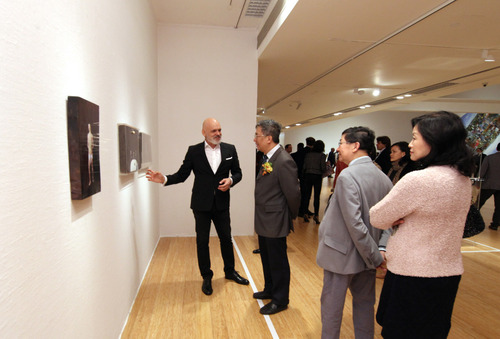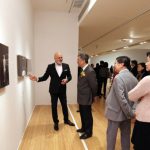 Opening ceremony of “Ad Lib – Recent Works of Konstantin Bessmertny”
Opening ceremony of “Ad Lib – Recent Works of Konstantin Bessmertny”
The Macao Museum of Art (MAM), under the Cultural Affairs Bureau (IC), inaugurated the great contemporary art exhibition “Ad Lib – Recent Works of Konstantin Bessmertny” today, 11 November, at 6:30pm, at the Gallery of Special Exhibitions of MAM, 2nd floor. This exhibition features a total of 34 recent works by the top artist Konstantin Bessmertny in the forms of painting, sculpture, installation and mixed media, offering viewers a bustling and humorous visual feast. The opening ceremony of the exhibition was officiated by the Acting President of the Cultural Affairs Bureau, Leung Hio Ming; the Acting Director of the Macao Government Tourism Office, Cecilia Tse Heng Sai; the veteran curator and art critic, Oscar Ho; famous designer, Henry Steiner, and the artist, Konstantin Bessmertny. The Director of MAM, Chan Hou Seng, accompanied the guests in a tour of the exhibition. The title of the exhibition is “Ad lib”, is an abbreviation of the Latin word ad libitum which is rooted in the notions of liberty and is a command or an invitation by a composer or dramatist, to improvise in music and drama. The application of the term in the exhibition title shows that the artist does not wish to give the exhibition a definite theme; instead he chooses to bring viewers a bustling and humorous visual feast, aiming to respond to different phenomena happening in society. Having resided in Macao for over two decades, Konstantin Bessmertny was born in Blagoveshchensk, USSR in 1964 and graduated from the Institute of Fine Arts in Vladivostok, specialising in classical painting. Bessmertny is an artist of collage, clash, collision and conundrum. His profound studies in multiple mediums, dimensions and cultures in the fields of literature, music, history, politics, are reflected in multiple mediums, dimensions and cultures with great precision and intelligence. Bessmertny was primarily inspired by Macao’s history, its multicultural coexistence and by the city’s transformation into a gambling centre. He manifests the spiritual demeanour of the city with a visual language that is seemingly absurd, sharing his personal musings. The humorous approach he adopts in his works often amuse viewers. For instance, the artist seems to act as a comedian in “The Battle of Macao”, an enormous oil painting 4 metres wide featured in the exhibition, by using irony, criticism and suspicion. Through the historical figures, Venice, pandas, gondola rides, roulettes, ladies and other images in the painting, he impels viewers to contemplate what they usually do not think about the details and anecdotes of the daily occurrence. The exhibition “Ad Lib – Recent Works of Konstantin Bessmertny” is held until 28 May 2017. The “Artist’s Guided Tour”, to be held on Sunday, 13 November, from 3pm to 4pm, will be conducted by Konstantin Bessmertny in English. The Macao Orchestra will also present an orchestral ensemble performance on Sunday, 20 November, at 3pm, at the venue. In addition, guided tours in Cantonese will be held on Saturdays, Sundays and public holidays from 26 November, from 3pm to 4pm. Guided tours reserved for groups and schools, along with the “Amusing - Children’s Guided Tour Programme”, will be available from 29 November. For details of the aforementioned activities and application, please visit www.icm.gov.mo or www.MAM.gov.mo. For queries, please call MAM through tel. 8791 9814 during office hours. The Macao Museum of Art is located in NAPE, Avenida Xian Xing Hai, and is open daily from 10am to 7pm (no admittance after 6:30pm; closed on Mondays). The admission fee is MOP5.00, and admission is free on Sundays and public holidays.
View gallery



